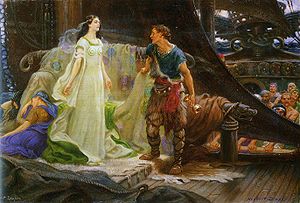Iseult

Iseult (/ɪˈsuːlt, ɪˈzuːlt/; alternatively Isolde /ɪˈsoʊldᵊ, ɪˈzoʊldᵊ/, Iseo, Yseult, Isode, Isoude, Esyllt, Isotta) is the name of several characters in the Arthurian story of Tristan and Iseult. The most prominent is Iseult of Ireland, wife of Mark of Cornwall and adulterous lover of Sir Tristan. Her mother, the Queen of Ireland, is also named Iseult. The third is Iseult of the White Hands, the daughter of Hoel of Brittany, sister of Sir Kahedin, and eventual wife of Tristan.
Iseult of Ireland
[edit]The Irish princess, Iseult of Ireland (also Iseult the Fair, La Bella Iseult), is the daughter of King Anguish of Ireland and Queen Iseult the Elder. She is a main character in the Tristan poems of Béroul, Thomas of Britain, and Gottfried von Strassburg and in the opera Tristan und Isolde by Richard Wagner.
Iseult is first seen as a young princess who heals Tristan from wounds he received fighting her uncle, Morholt. When his identity is revealed, Tristan flees back to his own land. Later, Tristan returns to Ireland to win Iseult's hand in marriage for his uncle, King Mark of Cornwall. She is supposed to marry an evil steward who claims that he has killed a dragon, but when Tristan proves that it was actually he who slew the beast, Iseult's parents agree to marry her to Mark. On the journey back to Cornwall, Iseult and Tristan accidentally drink a love potion prepared for her and Mark by Iseult the elder and guarded by Brangaine, Iseult's lady-in-waiting. The two fall hopelessly in love, and begin an affair that ends when Mark banishes Tristan from Cornwall.
In the verse tradition, the lovers do not meet again until Tristan is on his death bed (see below), but in the later Prose Tristan and works based upon it, Tristan returns from Brittany and they resume their affair. Mark is much less sympathetic in these versions, and the adulterers eventually flee from his wrath. Lancelot gives them refuge in his estate Joyous Garde, and they engage in many further adventures. Additional episodes are integrated into the earlier sections of the narrative as well, including several involving the great Saracen knight Palamedes' unrequited love for Iseult, and in some versions, the two even have children. In the prose versions, the lovers' end comes when Mark finds them as Tristan plays the harp for Iseult beneath a tree. The cruel king stabs his nephew in the back, and Tristan, at Iseult's request, fatally crushes his beloved in a tight embrace as his final act.
One of her rumored burial sites is Chapelizod in Dublin, Ireland.
Iseult of Brittany
[edit]After King Mark learns of the secret love affair between Tristan and Iseult, he banishes Tristan to Brittany, never to return to Cornwall. There, Tristan is placed in the care of Hoel of Brittany after receiving a wound. He meets and marries Hoel's daughter, Iseult, because she shares the name of his former lover. They never consummate the marriage because of Tristan's love for Iseult of Ireland.
During one adventure in Brittany, Tristan suffers a poisoned wound that only Iseult of Ireland, the world's most skilled physician, can cure. He sends a ship for her, asking that its crew fly white sails on the return if Iseult is aboard, and black if she is not. Iseult agrees to go, and the ship races home, white sails high. However, Tristan is too weak to look out his window to see the signal, so he asks his wife to check for him. In a moment of jealousy, Iseult of the White Hands tells him the sails are black, and Tristan expires immediately of despair. When the Irish Iseult arrives to find her lover dead, grief overcomes her, and she passes away at his side. This death sequence does not appear in the Prose Tristan. In fact, while Iseult of the White Hands figures into some of the new episodes, she is never mentioned again after Tristan returns to Cornwall, although her brother Kahedin remains a prominent character.
Modern portrayals
[edit]- Iseult of Ireland (as Isolde) was played by Sophia Myles in the 2006 film adaptation, Tristan & Isolde.
References
[edit]- Ronan Coghlan (editor) The Illustrated Encyclopedia of Arthurian Legends, New York, 1993.
- Norris J. Lacy (editor) The New Arthurian Encyclopedia, New York: Garland, 1996.
da:Isolde eu:Isolda Irlandakoa hu:Izolda no:Isolde pt:Isolda
